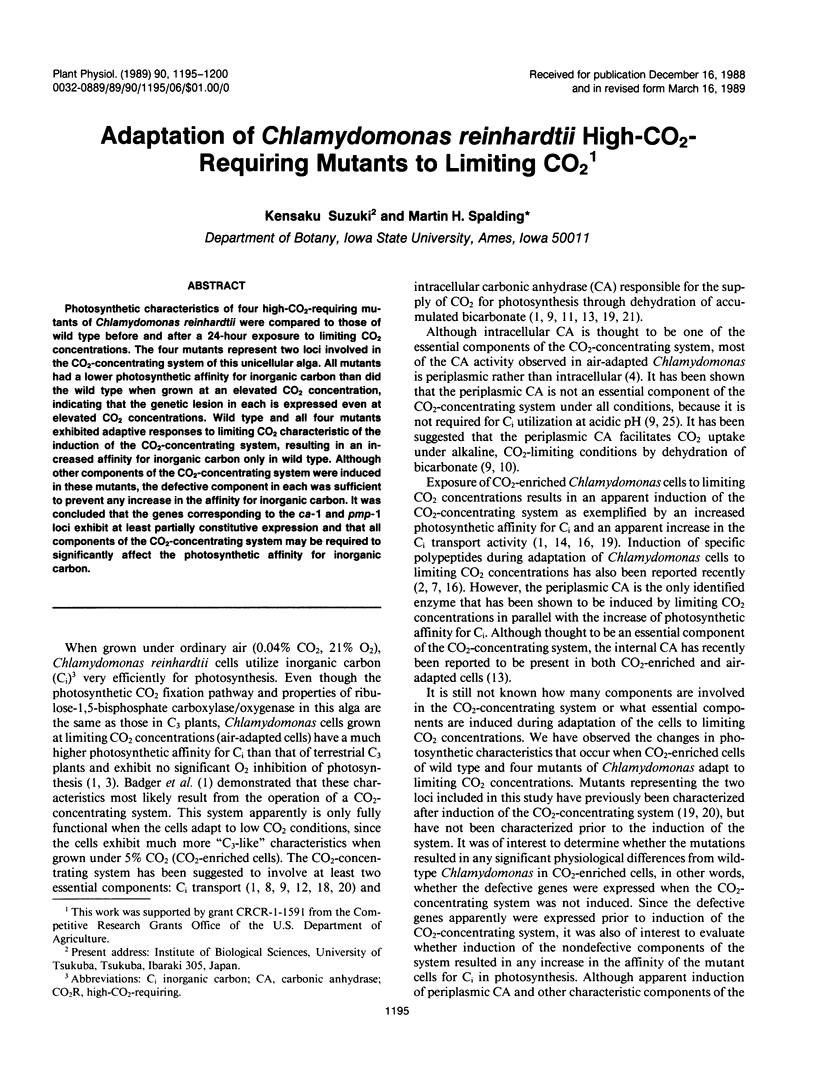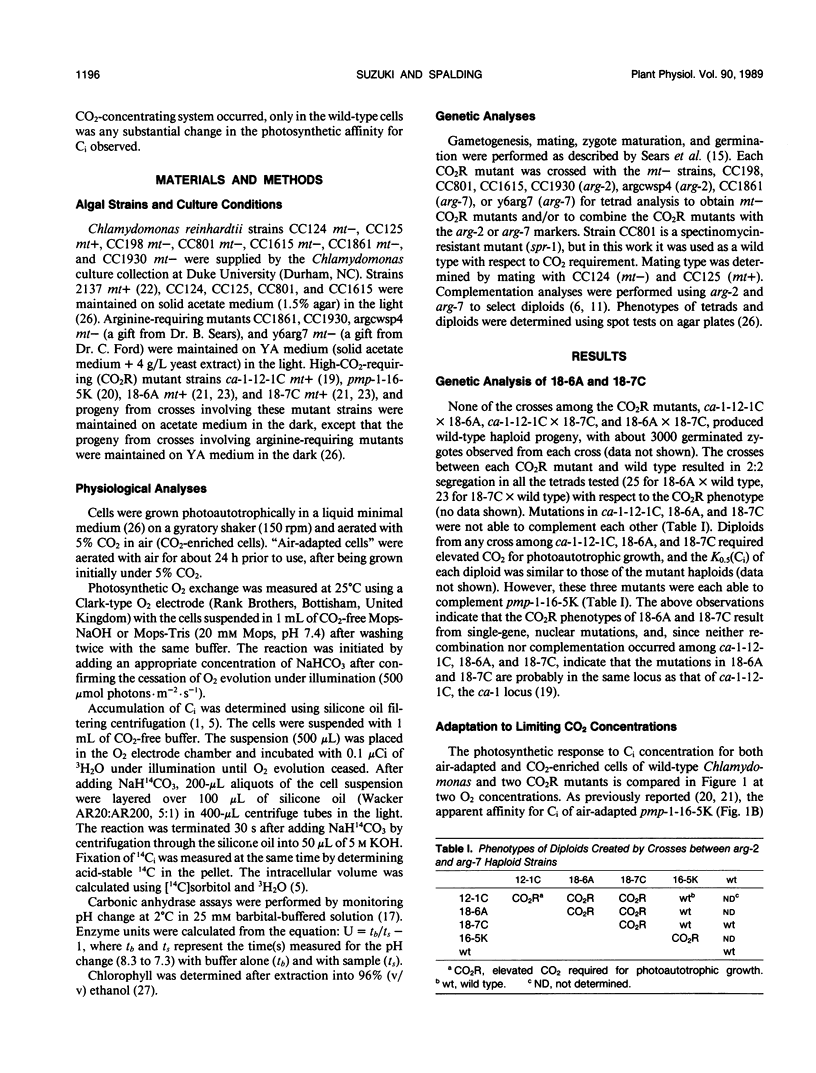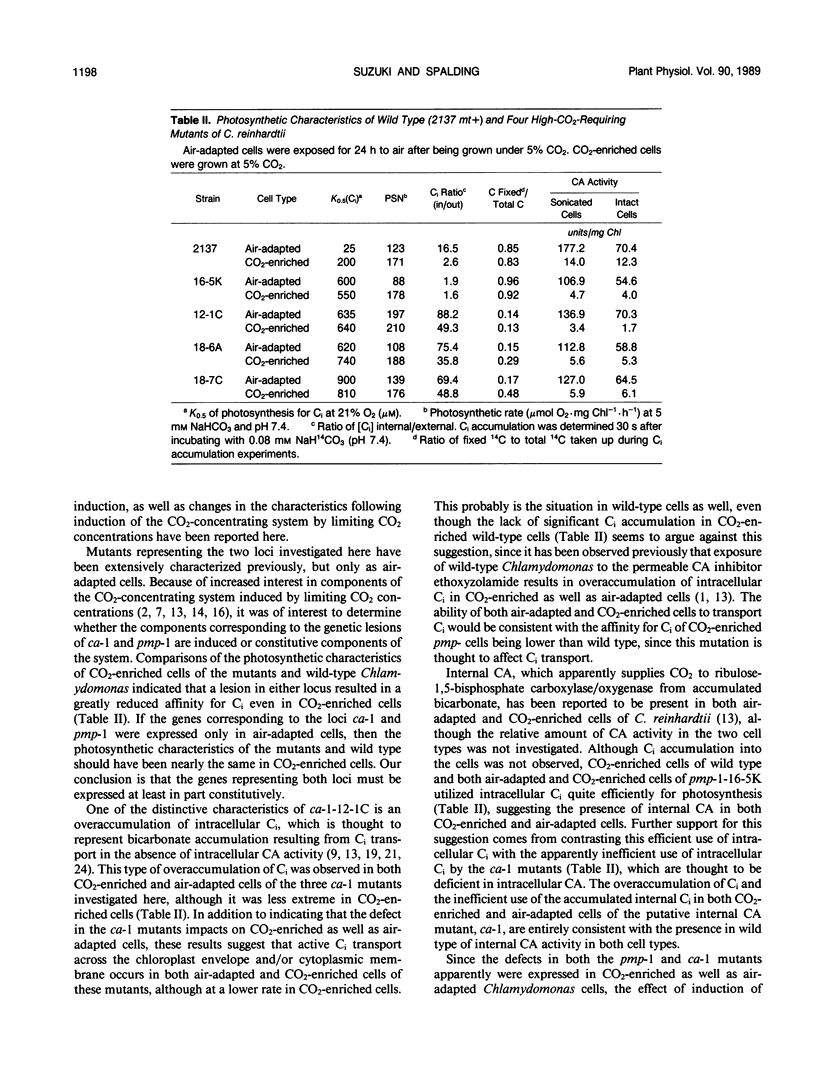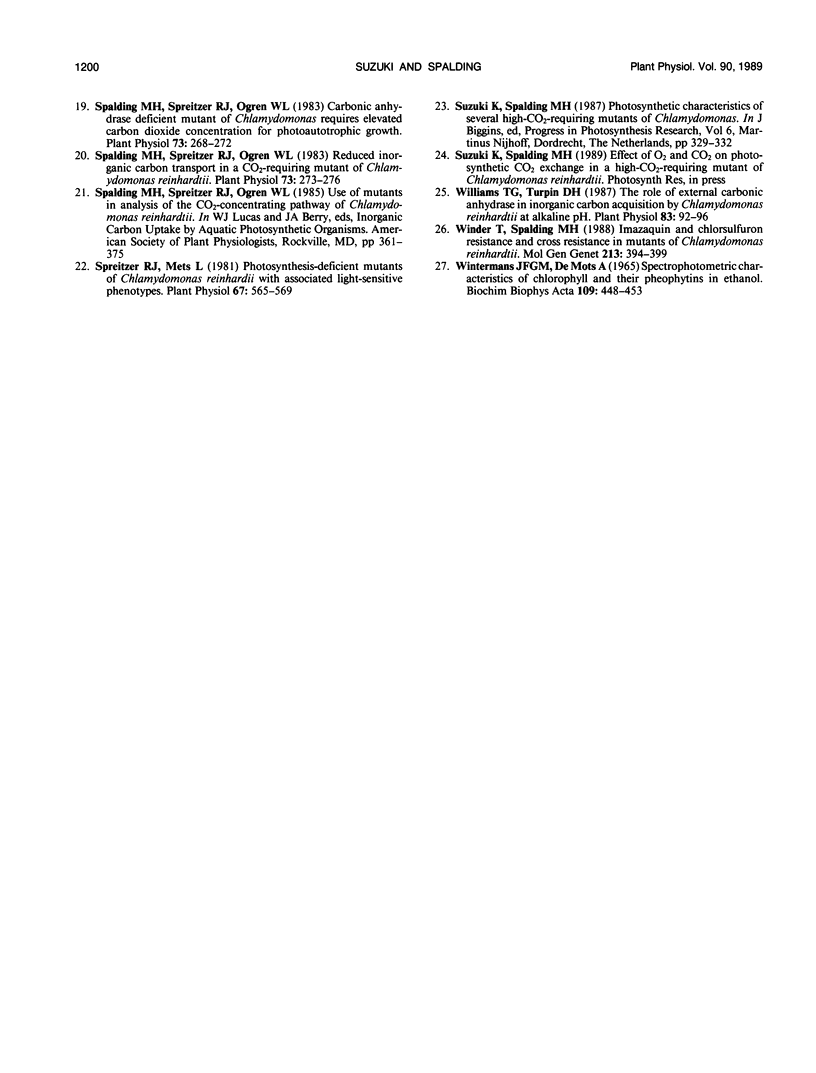Abstract
Photosynthetic characteristics of four high-CO2-requiring mutants of Chlamydomonas reinhardtii were compared to those of wild type before and after a 24-hour exposure to limiting CO2 concentrations. The four mutants represent two loci involved in the CO2-concentrating system of this unicellular alga. All mutants had a lower photosynthetic affinity for inorganic carbon than did the wild type when grown at an elevated CO2 concentration, indicating that the genetic lesion in each is expressed even at elevated CO2 concentrations. Wild type and all four mutants exhibited adaptive responses to limiting CO2 characteristic of the induction of the CO2-concentrating system, resulting in an increased affinity for inorganic carbon only in wild type. Although other components of the CO2-concentrating system were induced in these mutants, the defective component in each was sufficient to prevent any increase in the affinity for inorganic carbon. It was concluded that the genes corresponding to the ca-1 and pmp-1 loci exhibit at least partially constitutive expression and that all components of the CO2-concentrating system may be required to significantly affect the photosynthetic affinity for inorganic carbon.
Full text
PDF





Selected References
These references are in PubMed. This may not be the complete list of references from this article.
- Badger M. R., Kaplan A., Berry J. A. Internal Inorganic Carbon Pool of Chlamydomonas reinhardtii: EVIDENCE FOR A CARBON DIOXIDE-CONCENTRATING MECHANISM. Plant Physiol. 1980 Sep;66(3):407–413. doi: 10.1104/pp.66.3.407. [DOI] [PMC free article] [PubMed] [Google Scholar]
- Bailly J., Coleman J. R. Effect of CO(2) Concentration on Protein Biosynthesis and Carbonic Anhydrase Expression in Chlamydomonas reinhardtii. Plant Physiol. 1988 Aug;87(4):833–840. doi: 10.1104/pp.87.4.833. [DOI] [PMC free article] [PubMed] [Google Scholar]
- Coleman J. R., Berry J. A., Togasaki R. K., Grossman A. R. Identification of Extracellular Carbonic Anhydrase of Chlamydomonas reinhardtii. Plant Physiol. 1984 Oct;76(2):472–477. doi: 10.1104/pp.76.2.472. [DOI] [PMC free article] [PubMed] [Google Scholar]
- Manuel L. J., Moroney J. V. Inorganic Carbon Accumulation by Chlamydomonas reinhardtii: New Proteins are made During Adaptation to Low CO(2). Plant Physiol. 1988 Oct;88(2):491–496. doi: 10.1104/pp.88.2.491. [DOI] [PMC free article] [PubMed] [Google Scholar]
- Moroney J. V., Husic H. D., Tolbert N. E. Effect of Carbonic Anhydrase Inhibitors on Inorganic Carbon Accumulation by Chlamydomonas reinhardtii. Plant Physiol. 1985 Sep;79(1):177–183. doi: 10.1104/pp.79.1.177. [DOI] [PMC free article] [PubMed] [Google Scholar]
- Moroney J. V., Kitayama M., Togasaki R. K., Tolbert N. E. Evidence for Inorganic Carbon Transport by Intact Chloroplasts of Chlamydomonas reinhardtii. Plant Physiol. 1987 Mar;83(3):460–463. doi: 10.1104/pp.83.3.460. [DOI] [PMC free article] [PubMed] [Google Scholar]
- Moroney J. V., Togasaki R. K., Husic H. D., Tolbert N. E. Evidence That an Internal Carbonic Anhydrase Is Present in 5% CO(2)-Grown and Air-Grown Chlamydomonas. Plant Physiol. 1987 Jul;84(3):757–761. doi: 10.1104/pp.84.3.757. [DOI] [PMC free article] [PubMed] [Google Scholar]
- Moroney J. V., Tolbert N. E. Inorganic Carbon Uptake by Chlamydomonas reinhardtii. Plant Physiol. 1985 Feb;77(2):253–258. doi: 10.1104/pp.77.2.253. [DOI] [PMC free article] [PubMed] [Google Scholar]
- Palmqvist K., Sjöberg S., Samuelsson G. Induction of Inorganic Carbon Accumulation in the Unicellular Green Algae Scenedesmus obliquus and Chlamydomonas reinhardtii. Plant Physiol. 1988 Jun;87(2):437–442. doi: 10.1104/pp.87.2.437. [DOI] [PMC free article] [PubMed] [Google Scholar]
- Sears B. B., Boynton J. E., Gillham N. W. The Effect of Gametogenesis Regimes on the Chloroplast Genetic System of CHLAMYDOMONAS REINHARDTII. Genetics. 1980 Sep;96(1):95–114. doi: 10.1093/genetics/96.1.95. [DOI] [PMC free article] [PubMed] [Google Scholar]
- Spalding M. H., Jeffrey M. Membrane-Associated Polypeptides Induced in Chlamydomonas by Limiting CO(2) Concentrations. Plant Physiol. 1989 Jan;89(1):133–137. doi: 10.1104/pp.89.1.133. [DOI] [PMC free article] [PubMed] [Google Scholar]
- Spalding M. H., Spreitzer R. J., Ogren W. L. Carbonic Anhydrase-Deficient Mutant of Chlamydomonas reinhardii Requires Elevated Carbon Dioxide Concentration for Photoautotrophic Growth. Plant Physiol. 1983 Oct;73(2):268–272. doi: 10.1104/pp.73.2.268. [DOI] [PMC free article] [PubMed] [Google Scholar]
- Spalding M. H., Spreitzer R. J., Ogren W. L. Reduced Inorganic Carbon Transport in a CO(2)-Requiring Mutant of Chlamydomonas reinhardii. Plant Physiol. 1983 Oct;73(2):273–276. doi: 10.1104/pp.73.2.273. [DOI] [PMC free article] [PubMed] [Google Scholar]
- Spreitzer R. J., Mets L. Photosynthesis-deficient Mutants of Chlamydomonas reinhardii with Associated Light-sensitive Phenotypes. Plant Physiol. 1981 Mar;67(3):565–569. doi: 10.1104/pp.67.3.565. [DOI] [PMC free article] [PubMed] [Google Scholar]
- Williams T. G., Turpin D. H. The Role of External Carbonic Anhydrase in Inorganic Carbon Acquisition by Chlamydomonas reinhardii at Alkaline pH. Plant Physiol. 1987 Jan;83(1):92–96. doi: 10.1104/pp.83.1.92. [DOI] [PMC free article] [PubMed] [Google Scholar]
- Winder T., Spalding M. H. Imazaquin and chlorsulfuron resistance and cross resistance in mutants of Chlamydomonas reinhardtii. Mol Gen Genet. 1988 Aug;213(2-3):394–399. doi: 10.1007/BF00339608. [DOI] [PubMed] [Google Scholar]
- Wintermans J. F., de Mots A. Spectrophotometric characteristics of chlorophylls a and b and their pheophytins in ethanol. Biochim Biophys Acta. 1965 Nov 29;109(2):448–453. doi: 10.1016/0926-6585(65)90170-6. [DOI] [PubMed] [Google Scholar]


